How Much Forest Persists Through Fire? High-Resolution Mapping of Tree Cover to Characterize the Abundance and Spatial Pattern of Fire Refugia Across Mosaics of Burn Severity
Abstract
1. Introduction
2. Materials and Methods
2.1. Study Area and Fire Selection
2.2. Image Classification and Fire-Refugia Mapping
2.3. Refugia Abundance, Size, and Spatial Distribution
2.4. Optimal Threshold Determination and Classification Assessments
3. Results
3.1. Map Accuracy
3.2. Refugia Abundance, Size, and Spatial Distribution
3.3. Optimal Threshold Determination and Assessment
4. Discussion
4.1. Refugia Abundance and Burn Severity Context
4.2. Refugia Patch Size and Spatial Distribution
4.3. Optimal Threshold Determination and Assessment
5. Conclusions
Supplementary Materials
Author Contributions
Funding
Acknowledgments
Conflicts of Interest
References
- Agee, J.K. The landscape ecology of western forest fire regimes. Northwest Sci. 1998, 72, 24–34. [Google Scholar]
- Whitlock, C.; Shafer, S.L.; Marlon, J. The role of climate and vegetation change in shaping past and future fire regimes in the northwestern US and the implications for ecosystem management. For. Ecol. Manag. 2003, 178, 5–21. [Google Scholar] [CrossRef]
- Collins, B.M.; Stephens, S.L. Stand-replacing patches within a “mixed severity” fire regime: Quantitative characterization using recent fires in a long-established natural fire area. Landsc. Ecol. 2010, 25, 927–939. [Google Scholar] [CrossRef]
- Keyser, A.; Westerling, A. Climate drives inter-annual variability in probability of high severity fire occurrence in the western United States. Environ. Res. Lett. 2017, 12, 065003. [Google Scholar] [CrossRef]
- Parks, S.; Holsinger, L.; Panunto, M.; Jolly, W.M.; Dobrowski, S.; Dillon, G. High severity fire: Evaluating its key drivers and mapping its probability across western US forests. Environ. Res. Lett. 2018, 13, 044037. [Google Scholar] [CrossRef]
- Meddens, A.J.; Kolden, C.A.; Lutz, J.A.; Smith, A.M.; Cansler, C.A.; Abatzoglou, J.T.; Meigs, G.W.; Downing, W.M.; Krawchuk, M.A. Fire Refugia: What Are They, and Why Do They Matter for Global Change? BioScience 2018, 68, 944–954. [Google Scholar] [CrossRef]
- Keppel, G.; Van Niel, K.P.; Wardell-Johnson, G.W.; Yates, C.J.; Byrne, M.; Mucina, L.; Schut, A.G.T.; Hopper, S.D.; Franklin, S.E. Refugia: Identifying and understanding safe havens for biodiversity under climate change. Glob. Ecol. Biogeogr. 2012, 21, 393–404. [Google Scholar] [CrossRef]
- Camp, A.; Oliver, C.; Hessburg, P.; Everett, R. Predicting late-successional fire refugia pre-dating European settlement in the Wenatchee Mountains. For. Ecol. Manag. 1997, 95, 63–77. [Google Scholar] [CrossRef]
- Krawchuk, M.A.; Haire, S.L.; Coop, J.; Parisien, M.-A.; Whitman, E.; Chong, G.; Miller, C. Topographic and fire weather controls of fire refugia in forested ecosystems of northwestern North America. Ecosphere 2016, 7, e01632. [Google Scholar] [CrossRef]
- Ouarmim, S.; Paradis, L.; Asselin, H.; Bergeron, Y.; Ali, A.; Hély, C. Burning potential of fire refuges in the boreal mxedwood forest. Forests 2016, 7, 246. [Google Scholar] [CrossRef]
- Coop, J.D.; DeLory, T.J.; Downing, W.M.; Haire, S.L.; Krawchuk, M.A.; Miller, C.; Perisient, M.-A.; Walker, R.B. Contributions of fire refugia to resilient ponderosa pine and dry mixed-conifer forest landscapes. Ecosphere 2019, 10, e02809. [Google Scholar] [CrossRef]
- Downing, W.M.; Krawchuk, M.A.; Meigs, G.W.; Haire, S.L.; Coop, J.D.; Walker, R.B.; Whitman, E.; Chong, G.; Miller, C. Influence of fire refugia spatial pattern on post-fire forest recovery in Oregon’s Blue Mountains. Landsc. Ecol. 2019, 34, 771–792. [Google Scholar] [CrossRef]
- Landesmann, J.B.; Morales, J.M. The importance of fire refugia in the recolonization of a fire-sensitive conifer in northern Patagonia. Plant Ecol. 2018, 219, 455–466. [Google Scholar] [CrossRef]
- Barton, A.M.; Poulos, H.M. Pine vs. oaks revisited: Conversion of Madrean pine-oak forest to oak shrubland after high-severity wildfire in the Sky Islands of Arizona. For. Ecol. Manag. 2018, 414, 28–40. [Google Scholar] [CrossRef]
- Chambers, M.E.; Fornwalt, P.J.; Malone, S.L.; Battaglia, M.A. Patterns of conifer regeneration following high severity wildfire in ponderosa pine—Dominated forests of the Colorado Front Range. For. Ecol. Manag. 2016, 378, 57–67. [Google Scholar] [CrossRef]
- Coop, J.D.; Parks, S.A.; McClernan, S.R.; Holsinger, L.M. Influences of prior wildfires on vegetation response to subsequent fire in a reburned Southwestern landscape. Ecol. Appl. 2016, 26, 346–354. [Google Scholar] [CrossRef] [PubMed]
- Haffey, C.; Sisk, T.D.; Allen, C.D.; Thode, A.E.; Margolis, E.Q. Limits to ponderosa pine regeneration following large high-severity forest fires in the Unites States Southwest. Fire Ecol. 2018, 14, 143–163. [Google Scholar]
- Savage, M.; Mast, J.N. How resilient are southwestern ponderosa pine forests after crown fires? Can. J. For. Res. 2005, 35, 967–977. [Google Scholar] [CrossRef]
- Tepley, A.J.; Thompson, J.R.; Epstein, H.E.; Anderson-Teixeira, K.J. Vulnerability to forest loss through altered postfire recovery dynamics in a warming climate in the Klamath Mountains. Glob. Chang. Biol. 2017, 23, 4117–4132. [Google Scholar] [CrossRef]
- Cansler, C.A.; McKenzie, D. How robust are burn severity indices when applied in a new region? Evaluation of alternate feld-based and remote-sensing methods. Remote Sens. 2012, 4, 456–483. [Google Scholar] [CrossRef]
- French, N.H.F.; Kasischke, E.S.; Hall, R.J.; Murphy, K.A.; Verbyla, D.L.; Hoy, E.E.; Allen, J.L. Using Landsat data to assess fire and burn severity in the North American boreal forest region: An overview and summary of results. Int. J. Wildland Fire 2008, 17, 443. [Google Scholar] [CrossRef]
- López-García, M.J.; Caselles, V. Mapping burns and natural reforestation using thematic Mapper data. Geocarto Int. 1991, 6, 31–37. [Google Scholar] [CrossRef]
- Key, C.H.; Benson, N.C. Landscape assessment: Remote sensing of severity, the Normalized Burn Ratio; and Ground measure of severity, the Composite Burn Index. In FIREMON: Fire Effects Monitoring and Inventory System; General Technical Report RMRS-GTR-164-CD:LA1-LA51 2005; Lutes, D.C., Keane, R.E., Caratti, J.F., Key, C.H., Benson, N.C., Gangi, L.J., Eds.; U.S. Department of Agriculture, Forest Service, Rocky Mountain Research Station: Ogden, UT, USA, 2006. [Google Scholar]
- Miller, J.D.; Thode, A.E. Quantifying burn severity in a heterogeneous landscape with a relative version of the delta Normalized Burn Ratio (dNBR). Remote Sens. Environ. 2007, 109, 66–80. [Google Scholar] [CrossRef]
- Eidenshink, J.; Schwind, B.; Brewer, K.; Zhu, Z.-L.; Quayle, B.; Howard, S. A Project for Monitoring Trends in Burn Severity. Fire Ecol. 2007, 3, 3–21. [Google Scholar] [CrossRef]
- Kolden, C.A.; Smith, A.M.S.; Abatzoglou, J.T. Limitations and utilisation of Monitoring Trends in Burn Severity products for assessing wildfire severity in the USA. Int. J. Wildland Fire 2015, 7, 1023–1028. [Google Scholar] [CrossRef]
- Berry, L.E.; Driscoll, D.A.; Stein, J.A.; Blanchard, W.; Banks, S.C.; Bradstock, R.A.; Lindenmayer, D.B. Identifying the location of fire refuges in wet forest ecosystems. Ecol. Appl. 2015, 25, 2337–2348. [Google Scholar] [CrossRef]
- Haire, S.; Coop, J.D.; Miller, C. Characterizing Spatial Neighborhoods of Refugia Following Large Fires in Northern New Mexico USA. Land 2017, 6, 19. [Google Scholar] [CrossRef]
- Kolden, C.A.; Lutz, J.A.; Key, C.H.; Kane, J.T.; van Wagtendonk, J.W. Mapped versus actual burned area within wildfire perimeters: Characterizing the unburned. For. Ecol. Manag. 2012, 286, 38–47. [Google Scholar] [CrossRef]
- Meddens, A.J.H.; Kolden, C.A.; Lutz, J.A. Detecting unburned areas within wildfire perimeters using Landsat and ancillary data across the northwestern United States. Remote Sens. Environ. 2016, 186, 275–285. [Google Scholar] [CrossRef]
- Davies, K.W.; Petersen, S.L.; Johnson, D.D.; Davis, D.B.; Madsen, M.D.; Zvirzdin, D.L.; Bates, J.D. Estimating juniper cover from National Agriculture Imagery Program (NAIP) Imagery and evaluating relationships between potential cover and environmental variables. Rangel. Ecol. Manag. 2010, 63, 630–637. [Google Scholar] [CrossRef]
- Liknes, G.C.; Perry, C.H.; Meneguzzo, D.M. Assessing tree cover in agricultural landscapes using high-resolution aerial imagery. J. Terr. Obs. 2010, 2, 38–55. [Google Scholar]
- Meneguzzo, D.M.; Liknes, G.C.; Nelson, M.D. Mapping trees outside forests using high-resolution aerial imagery: A comparison of pixel- and object-based classification approaches. Environ. Monit. Assess. 2013, 185, 6261–6275. [Google Scholar] [CrossRef] [PubMed]
- Everett, R.L.; Schellhaas, R.; Keenum, D.; Spurbeck, D.; Ohlson, P. Fire history in the ponderosa pine/Douglas-fir forests on the east slope of the Washington Cascades. For. Ecol. Manag. 2000, 129, 207–225. [Google Scholar] [CrossRef]
- Veblen, T.T.; Kitzberger, T.; Donnegan, J. Climatic and human influences on fire regimes in ponderosa pine forests in the Colorado Front Range. Ecol. Appl. 2000, 10, 1178–1195. [Google Scholar] [CrossRef]
- Vogelmann, J.E.; Howard, S.M.; Yang, L.; Larson, C.R.; Wylie, B.K.; Van Driel, J.N. Completion of the 1990’s National Land Cover Data Set for the conterminous United States. Photogramm. Eng. Remote Sens. 2001, 67, 650–662. [Google Scholar]
- EarthExplorer. Available online: https://earthexplorer.usgs.gov/ (accessed on 20 August 2016).
- Monitoring Trends in Burn Severity (MTBS). Available online: https://mtbs.gov/ (accessed on 20 August 2016).
- Esri. ArcGIS Desktop: Release 10.4.1; Environmental Systems Research Institute: Redlands, CA, USA, 2016. [Google Scholar]
- Cho, H.K.; Lee, W.K.; Lee, S.H. Mapping of vegetation cover using segment based classification of IKONOS imagery. Korean J. Ecol. 2003, 26, 75–81. [Google Scholar] [CrossRef]
- Kim, S.R.; Lee, W.K.; Kwak, D.A.; Biging, G.; Gong, P.; Lee, J.H.; Cho, H.K. Forest Cover Classification by Optimal Segmentation of High Resolution Satellite Imagery. Sensors 2011, 11, 1943–1958. [Google Scholar] [CrossRef]
- Congalton, R.G. A review of assessing the accuracy of classifications of remotely sensed data. Remote Sens. Environ. 1991, 37, 35–46. [Google Scholar] [CrossRef]
- Stehman, S.V.; Czaplewski, R.L. Design and analysis for thematic map accuracy assessment: fundamental principles. Remote Sens. Environ. 1998, 64, 331–344. [Google Scholar] [CrossRef]
- Cohen, J. A coefficient of agreement for nominal scales. Edu. Psychol. Meas. 1960, 20, 37–46. [Google Scholar] [CrossRef]
- McGarigal, K.; Cushman, S.A.; Ene, E. FRAGSTATS v4: Spatial Pattern Analysis Program for Categorical and Continuous Maps. Computer Software Program Produced by the Authors at the University of Massachusetts, Amherst. 2012. Available online: http://www.umass.edu/landeco/research/fragstats/fragstats.html (accessed on 1 February 2017).
- Reilly, M.J.; Dunn, C.J.; Meigs, G.W.; Spies, T.A.; Kennedy, R.E.; Bailey, J.D.; Briggs, K. Contemporary patterns of fire extent and severity in forests of the Pacific Northwest, USA (1985–2010). Ecosphere 2017, 8, e01695. [Google Scholar] [CrossRef]
- Robin, X.; Turck, N.; Hainard, A.; Tiberti, N.; Lisacek, F.; Sanchez, J.-C.; Müller, M. pROC: An open-source package for R and S+ to analyze and compare ROC curves. BMC Bioinform. 2011, 12, 77. [Google Scholar] [CrossRef] [PubMed]
- Freeman, E.A.; Moisen, G. PresenceAbsence: An R Package for Presence Absence Analysis. J. Stat. Softw. 2008, 23, 31. [Google Scholar] [CrossRef]
- Meigs, G.W.; Krawchuk, M.A. Composition and structure of forest fire refugia: What are the ecosystem legacies across burned landscapes? Forests 2018, 9, 243. [Google Scholar] [CrossRef]
- Meddens, A.J.H.; Kolden, C.A.; Lutz, J.A.; Abatzoglou, J.T.; Hudak, A.T. Spatiotemporal patterns of unburned areas within fire perimeters in the northwestern United States from 1984 to 2014. Ecosphere 2018, 9, e02029. [Google Scholar] [CrossRef]
- Hanson, C.T.; Sherriff, R.L.; Hutto, R.L.; DellaSala, D.A.; Veblen, T.T.; Baker, W.L. Setting the stage for mixed-and high-severity Fire. In The Ecological Importance of Mixed-Severity Fires; Elsevier: Amsterdam, The Netherlands, 2015. [Google Scholar]
- Robert, A. The effects of spatially correlated perturbations and habitat configuration on metapopulation persistence. Oikos 2009, 118, 1590–1600. [Google Scholar] [CrossRef]
- Simberloff, D.; Abele, L.G. Refuge Design and Island Biogeographic Theory: Effects of Fragmentation. Am. Nat. 1982, 120, 41–50. [Google Scholar] [CrossRef]
- Kane, V.R.; North, M.P.; Lutz, J.A.; Churchill, D.J.; Roberts, S.L.; Smith, D.F.; McGaughey, R.J.; Kane, J.T.; Brooks, M.L. Assessing fire effects on forest spatial structure using a fusion of Landsat and airborne LiDAR data in Yosemite National Park. Remote Sens. Environ. 2014, 151, 89–101. [Google Scholar] [CrossRef]
- Schlawin, J.R.; Zahawi, R.A. “Nucleating” succession in recovering neotropical wet forests: The legacy of remnant trees. J. Veg. Sci. 2008, 19, 485–492. [Google Scholar] [CrossRef]
- Yarranton, G.A.; Morrison, R.G. Spatial Dynamics of a Primary Succession: Nucleation. J. Ecol. 1974, 62, 417–428. [Google Scholar] [CrossRef]
- Corbin, J.D.; Holl, K.D. Applied nucleation as a forest restoration strategy. For. Ecol. Manag. 2012, 265, 37–46. [Google Scholar] [CrossRef]
- Toh, I.; Gillespie, M.; Lamb, D. The Role of Isolated Trees in Facilitating Tree Seedling Recruitment at a Degraded Sub-Tropical Rainforest Site. Restor. Ecol. 1999, 7, 288–297. [Google Scholar] [CrossRef]
- Kemp, K.B.; Higuera, P.E.; Morgan, P. Fire legacies impact conifer regeneration across environmental gradients in the U.S. northern Rockies. Landsc. Ecol. 2016, 31, 619–636. [Google Scholar] [CrossRef]
- Haire, S.L.; McGarigal, K. Effects of landscape patterns of fire severity on regenerating ponderosa pine forests in New Mexico and Arizona, USA. Landsc. Ecol. 2010, 25, 1055–1069. [Google Scholar] [CrossRef]
- Escuin, S.; Navarro, R.; Fernández, P. Fire severity assessment by using NBR (Normalized Burn Ratio) and NDVI (Normalized Difference Vegetation Index) derived from LANDSAT TM/ETM images. Int. J. Remote Sens. 2008, 29, 1053–1073. [Google Scholar] [CrossRef]
- Parks, S.; Dillon, G.; Miller, C. A New Metric for Quantifying Burn Severity: The Relativized Burn Ratio. Remote Sens. 2014, 6, 1827–1844. [Google Scholar] [CrossRef]
- Van Wagtendonk, J.W.; Root, R.R.; Key, C.H. Comparison of AVIRIS and Landsat ETM+ detection capabilities for burn severity. Remote Sens. Environ. 2004, 92, 397–408. [Google Scholar] [CrossRef]
- Alonzo, M.; Morton, D.C.; Cook, B.D.; Andersen, H.-E.; Babcock, C.; Pattison, R. Patterns of canopy and surface layer consumption in a boreal forest fire from repeat airborne lidar. Environ. Res. Lett. 2017, 12, 065004. [Google Scholar] [CrossRef]
- Bolton, D.K.; Coops, N.C.; Wulder, M.A. Characterizing residual structure and forest recovery following high-severity fire in the western boreal of Canada using Landsat time-series and airborne lidar data. Remote Sens. Environ. 2015, 163, 48–60. [Google Scholar] [CrossRef]
- Meng, R.; Wu, J.; Schwager, K.L.; Zhao, F.; Dennison, P.E.; Cook, B.D.; Brewster, K.; Green, T.M.; Serbin, S.P. Using high spatial resolution satellite imagery to map forest burn severity across spatial scales in a Pine Barrens ecosystem. Remote Sens. Environ. 2017, 191, 95–109. [Google Scholar] [CrossRef]
- Keppel, G.; Wardell-Johnson, G.W. Refugia: keys to climate change management. Glob. Chang. Biol. 2012, 18, 2389–2391. [Google Scholar] [CrossRef]
- Allen, C.D.; Savage, M.; Falk, D.A.; Suckling, K.F.; Swetnam, T.W.; Schulke, T.; Stacey, P.B.; Morgan, P.; Hoffman, M.; Klingel, J.T. Ecological Restoration of Southwestern Ponderosa Pine Ecosystems: A Broad Perspective. Ecol. Appl. 2002, 12, 1418–1433. [Google Scholar] [CrossRef]
- Johnstone, J.F.; Allen, C.D.; Franklin, J.F.; Frelich, L.E.; Harvey, B.J.; Higuera, P.E.; Mack, M.C.; Meentemeyer, R.K.; Metz, M.R.; Perry, G.L.; et al. Changing disturbance regimes, ecological memory, and forest resilience. Front. Ecol. Environ. 2016, 14, 369–378. [Google Scholar] [CrossRef]

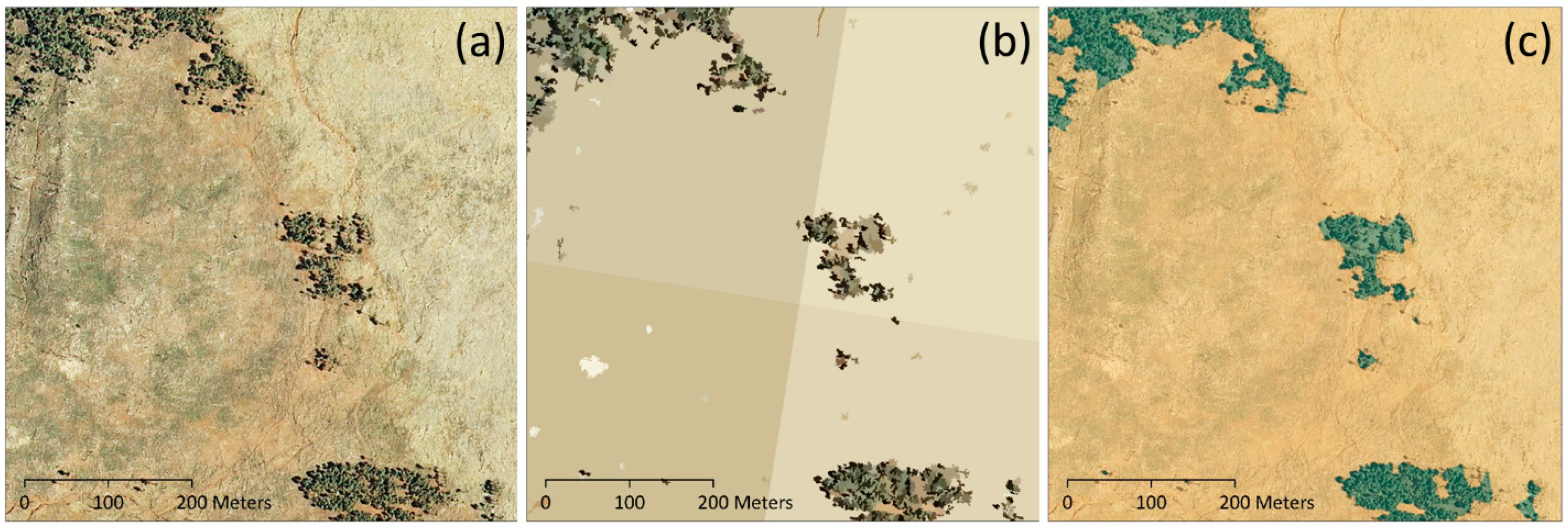
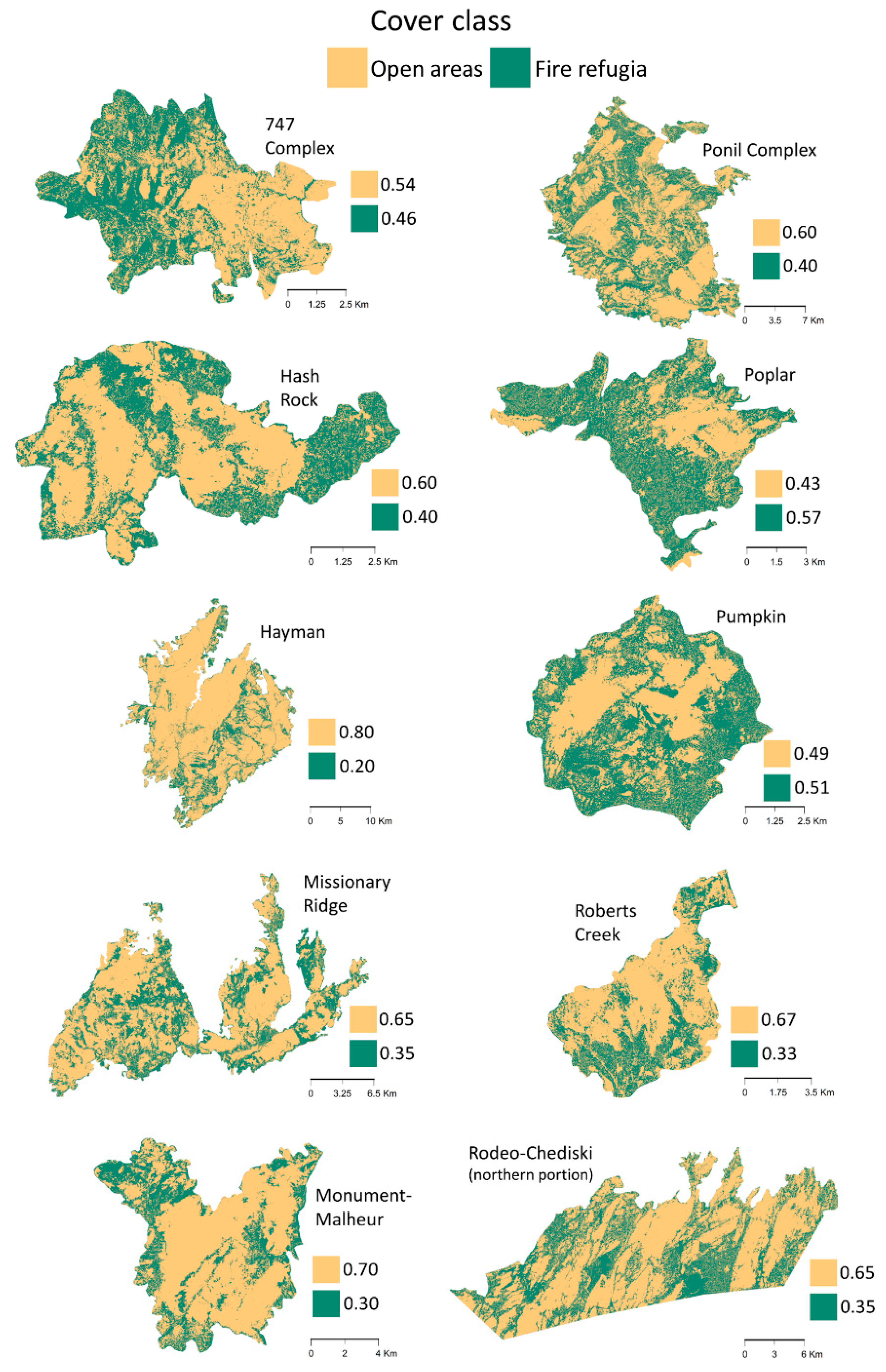
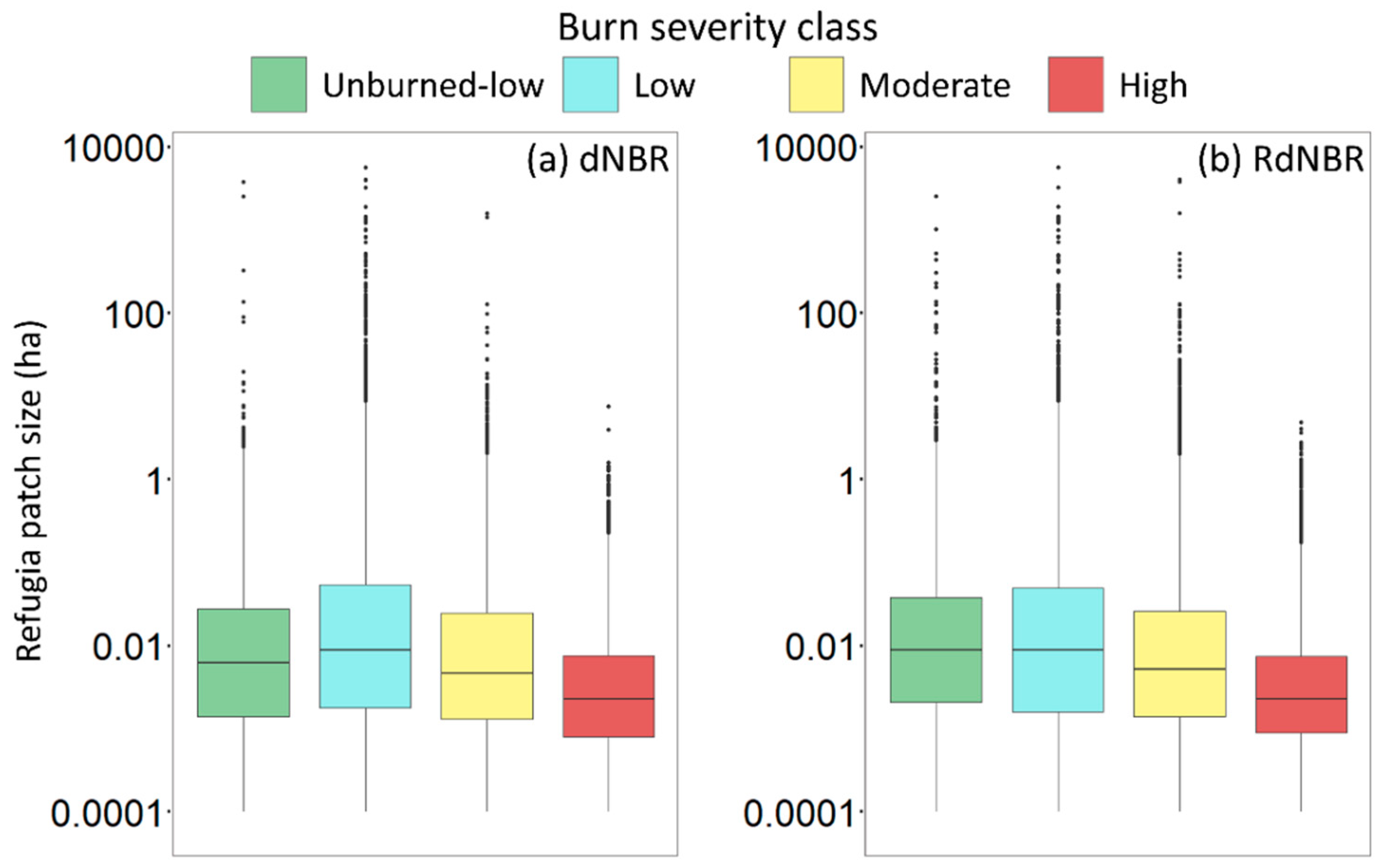
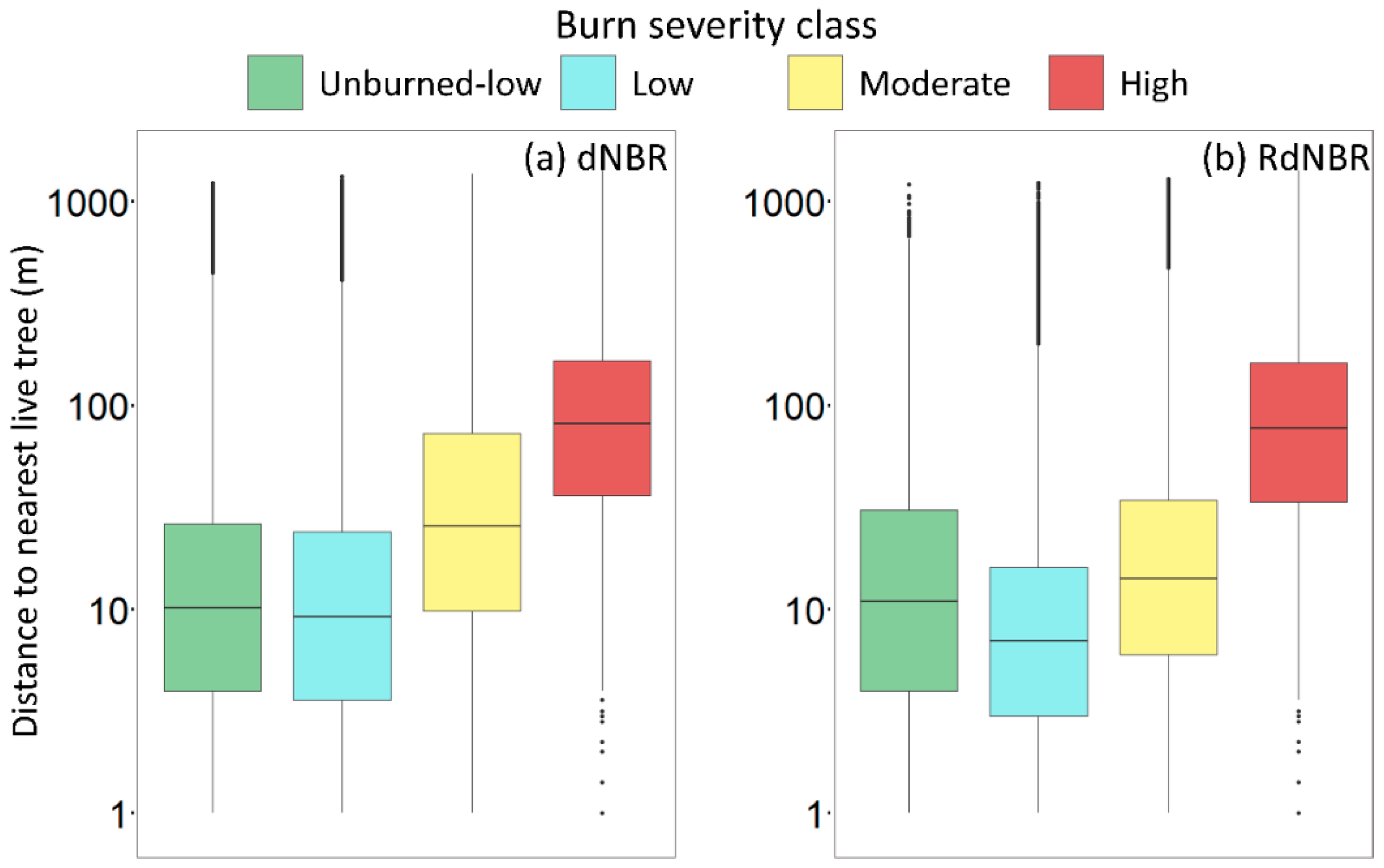
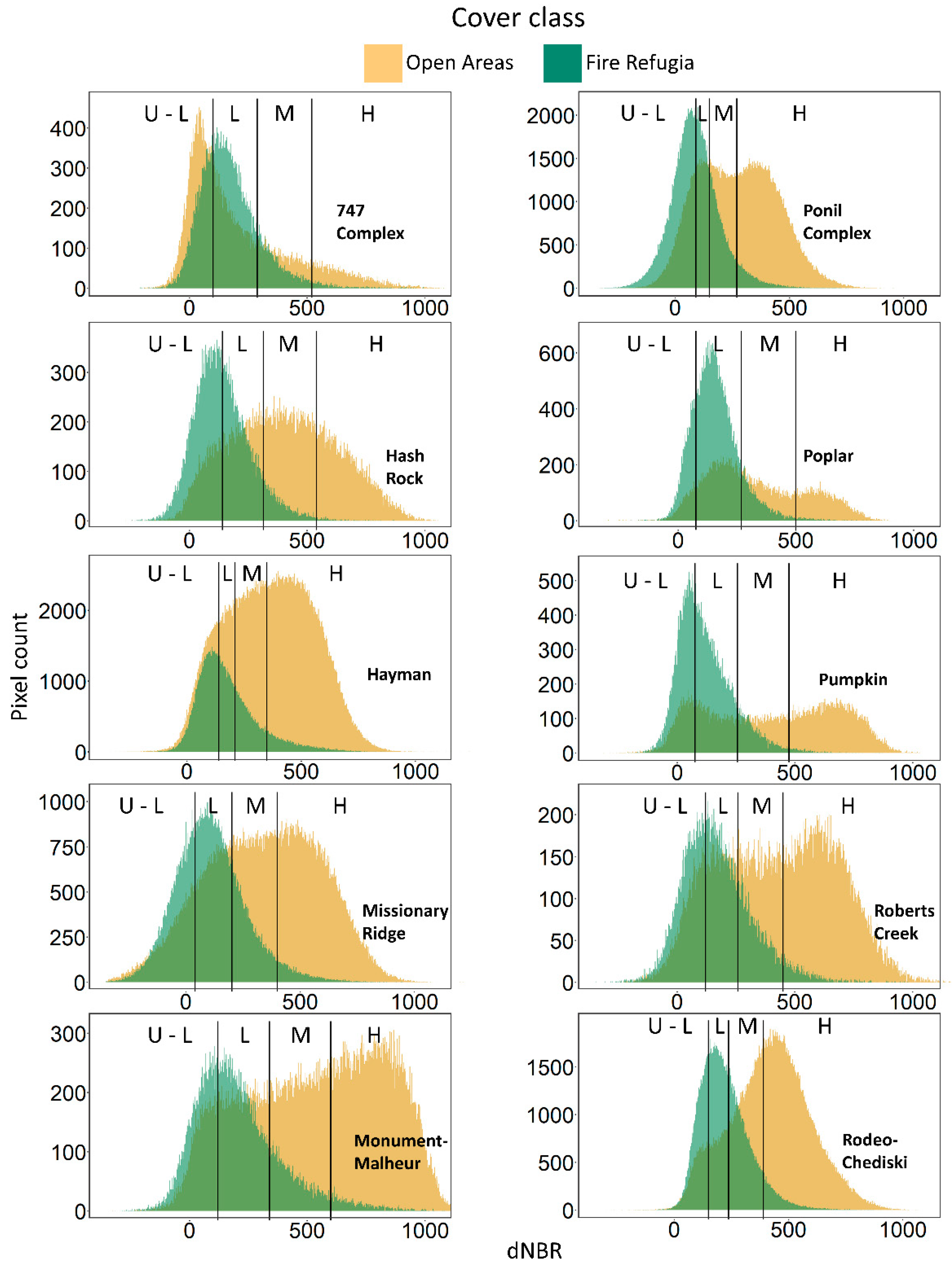
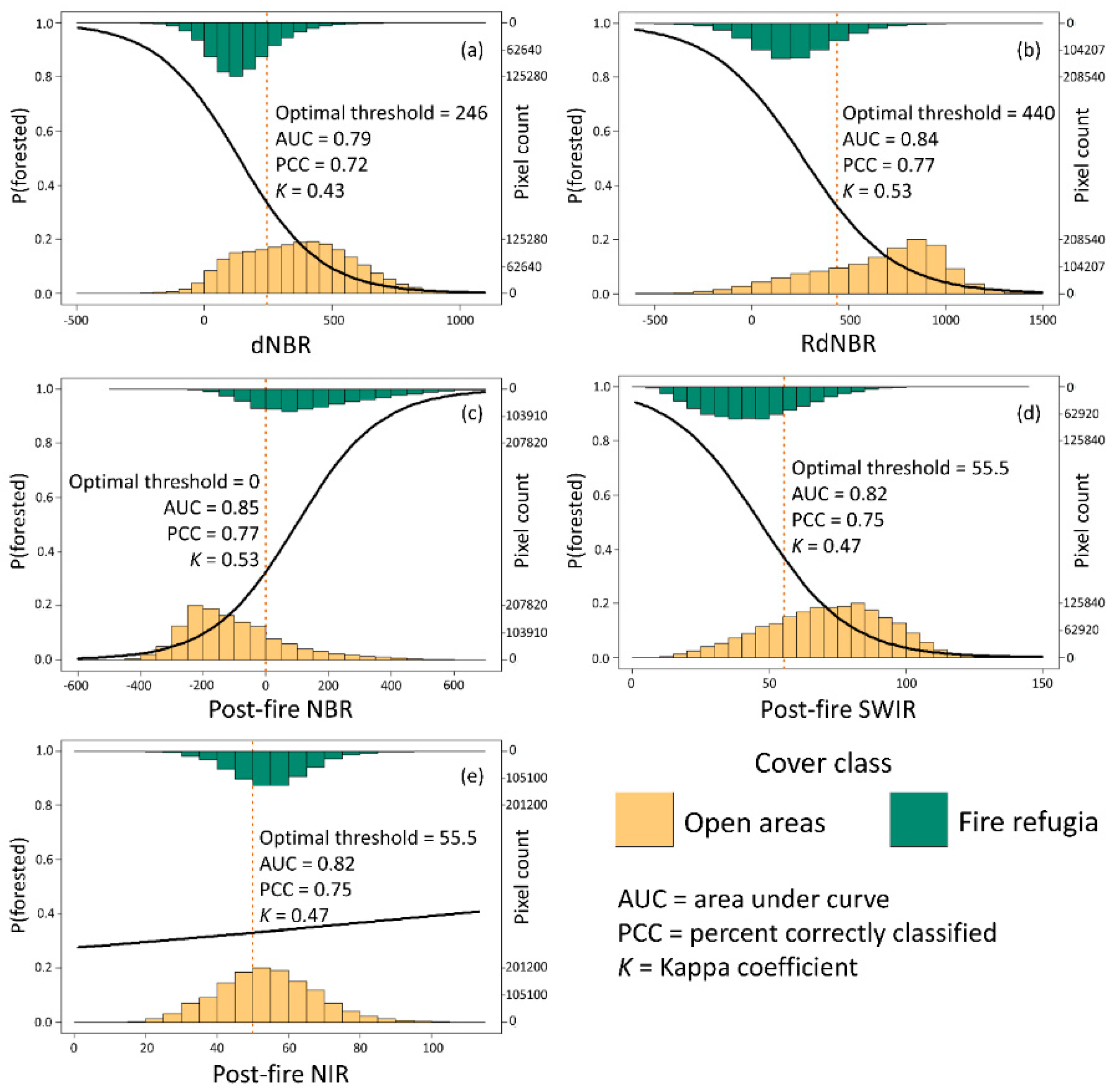
| NAIP Acquisition Date | Landsat Acquisition Date (Sensor) | |||||
|---|---|---|---|---|---|---|
| Fire | State | Year | Fire Start Day | Post-Fire | Pre-Fire | Post-Fire |
| 747 Complex | Oregon | 2002 | 13 July | 2012-07-23 | 2002-06-13 (ETM+) | 2003-07-10 (TM5) |
| Hash Rock | Oregon | 2000 | 23 August | 2014-07-05 | 2000-08-01 (ETM+) | 2001-08-20 (ETM+) |
| Hayman | Colorado | 2002 | 8 June | 2013-09-26 | 2001-08-24 (TM5) | 2003-08-14 (TM5) |
| Missionary Ridge | Colorado | 2002 | 9 June | 2011-08-08 | 2002-06-06 (TM5) | 2003-06-25 (TM5) |
| Monument-Malheur | Oregon | 2002 | 12 July | 2012-07-11 | 2001-08-06 (ETM+) | 2003-08-20 (TM5) |
| Ponil Complex | New Mexico | 2002 | 8 June | 2011-05-31 | 2001-05-20 (TM5) | 2003-10-17 (TM5) |
| Poplar | Arizona | 2003 | 30 September | 2013-06-20 | 2002-06-28 (ETM+) | 2004-07-11 (TM5) |
| Pumpkin | Arizona | 2000 | 25 May | 2013-06-07 | 1998-06-25 (TM5) | 2001-06-09 (ETM+) |
| Roberts Creek | Oregon | 2002 | 12 July | 2012-07-21 | 2001-08-06 (ETM+) | 2003-08-20 (TM5) |
| Rodeo-Chediski | Arizona | 2002 | 18 June | 2007-09-22 | 2001-05-01 (ETM+) | 2003-04-29 (TM5) |
| Producer’s Accuracy | User’s Accuracy | Total | ||||
|---|---|---|---|---|---|---|
| Fire | Open Areas | Fire Refugia | Open Areas | Fire Refugia | Accuracy | K |
| 747 Complex | 0.94 | 0.94 | 0.94 | 0.94 | 0.94 | 0.88 |
| Hash Rock | 0.90 | 0.94 | 0.94 | 0.90 | 0.92 | 0.84 |
| Hayman | 0.93 | 0.96 | 0.96 | 0.93 | 0.95 | 0.89 |
| Missionary Ridge | 0.98 | 0.90 | 0.91 | 0.98 | 0.94 | 0.88 |
| Monument-Malheur | 0.96 | 0.94 | 0.94 | 0.96 | 0.95 | 0.90 |
| Ponil Complex | 0.95 | 0.92 | 0.92 | 0.95 | 0.94 | 0.87 |
| Poplar | 0.89 | 0.93 | 0.93 | 0.89 | 0.91 | 0.82 |
| Pumpkin | 0.88 | 0.99 | 0.99 | 0.89 | 0.94 | 0.87 |
| Roberts Creek | 1.00 | 0.91 | 0.90 | 1.00 | 0.95 | 0.90 |
| Rodeo-Chediski | 0.93 | 0.94 | 0.94 | 0.93 | 0.94 | 0.87 |
| Overall mean | 0.94 | 0.94 | 0.94 | 0.94 | 0.94 | 0.87 |
| Producer’s Accuracy | User’s Accuracy | Total | ||||
|---|---|---|---|---|---|---|
| Fire | Open Areas | Fire Refugia | Open Areas | Fire Refugia | Accuracy | K |
| 747 Complex | 0.98 | 0.88 | 0.96 | 0.95 | 0.95 | 0.88 |
| Hash Rock | 0.95 | 1.00 | 1.00 | 0.85 | 0.96 | 0.89 |
| Hayman | 0.98 | 0.88 | 0.96 | 0.95 | 0.95 | 0.88 |
| Missionary Ridge | 1.00 | 0.92 | 0.97 | 1.00 | 0.98 | 0.95 |
| Monument-Malheur | - | - | - | - | - | - |
| Ponil Complex | 1.00 | 0.80 | 0.92 | 1.00 | 0.94 | 0.85 |
| Poplar | 0.97 | 0.87 | 0.95 | 0.93 | 0.94 | 0.86 |
| Pumpkin | 0.97 | 0.92 | 0.97 | 0.92 | 0.96 | 0.90 |
| Roberts Creek | 0.94 | 0.86 | 0.94 | 0.86 | 0.92 | 0.80 |
| Rodeo-Chediski | 1.00 | 0.89 | 0.96 | 1.00 | 0.97 | 0.92 |
| Overall mean | 0.98 | 0.89 | 0.96 | 0.94 | 0.95 | 0.89 |
| High | Moderate | Low | Unburned-Low | |||||
|---|---|---|---|---|---|---|---|---|
| Fire | Fire refugia | Open Areas | Fire Refugia | Open Areas | Fire Refugia | Open Areas | Fire Refugia | Open Areas |
| 747 Complex | 0.12 | 0.88 | 0.42 | 0.58 | 0.61 | 0.39 | 0.38 | 0.62 |
| Hash Rock | 0.01 | 0.99 | 0.13 | 0.87 | 0.52 | 0.48 | 0.72 | 0.28 |
| Hayman | 0.05 | 0.95 | 0.19 | 0.81 | 0.37 | 0.63 | 0.44 | 0.56 |
| Missionary Ridge | 0.04 | 0.96 | 0.21 | 0.79 | 0.51 | 0.49 | 0.60 | 0.40 |
| Monument-Malheur | 0.05 | 0.95 | 0.30 | 0.70 | 0.56 | 0.44 | 0.59 | 0.41 |
| Ponil Complex | 0.07 | 0.93 | 0.36 | 0.64 | 0.55 | 0.45 | 0.68 | 0.32 |
| Poplar | 0.05 | 0.95 | 0.34 | 0.66 | 0.71 | 0.29 | 0.76 | 0.24 |
| Pumpkin | 0.03 | 0.97 | 0.36 | 0.64 | 0.72 | 0.28 | 0.74 | 0.26 |
| Roberts Creek | 0.04 | 0.96 | 0.31 | 0.69 | 0.52 | 0.48 | 0.60 | 0.40 |
| Rodeo-Chediski | 0.06 | 0.94 | 0.40 | 0.60 | 0.68 | 0.32 | 0.65 | 0.35 |
| Overall mean | 0.05 | 0.95 | 0.30 | 0.70 | 0.57 | 0.43 | 0.62 | 0.38 |
© 2019 by the authors. Licensee MDPI, Basel, Switzerland. This article is an open access article distributed under the terms and conditions of the Creative Commons Attribution (CC BY) license (http://creativecommons.org/licenses/by/4.0/).
Share and Cite
B. Walker, R.; D. Coop, J.; M. Downing, W.; A. Krawchuk, M.; L. Malone, S.; W. Meigs, G. How Much Forest Persists Through Fire? High-Resolution Mapping of Tree Cover to Characterize the Abundance and Spatial Pattern of Fire Refugia Across Mosaics of Burn Severity. Forests 2019, 10, 782. https://doi.org/10.3390/f10090782
B. Walker R, D. Coop J, M. Downing W, A. Krawchuk M, L. Malone S, W. Meigs G. How Much Forest Persists Through Fire? High-Resolution Mapping of Tree Cover to Characterize the Abundance and Spatial Pattern of Fire Refugia Across Mosaics of Burn Severity. Forests. 2019; 10(9):782. https://doi.org/10.3390/f10090782
Chicago/Turabian StyleB. Walker, Ryan, Jonathan D. Coop, William M. Downing, Meg A. Krawchuk, Sparkle L. Malone, and Garrett W. Meigs. 2019. "How Much Forest Persists Through Fire? High-Resolution Mapping of Tree Cover to Characterize the Abundance and Spatial Pattern of Fire Refugia Across Mosaics of Burn Severity" Forests 10, no. 9: 782. https://doi.org/10.3390/f10090782
APA StyleB. Walker, R., D. Coop, J., M. Downing, W., A. Krawchuk, M., L. Malone, S., & W. Meigs, G. (2019). How Much Forest Persists Through Fire? High-Resolution Mapping of Tree Cover to Characterize the Abundance and Spatial Pattern of Fire Refugia Across Mosaics of Burn Severity. Forests, 10(9), 782. https://doi.org/10.3390/f10090782






